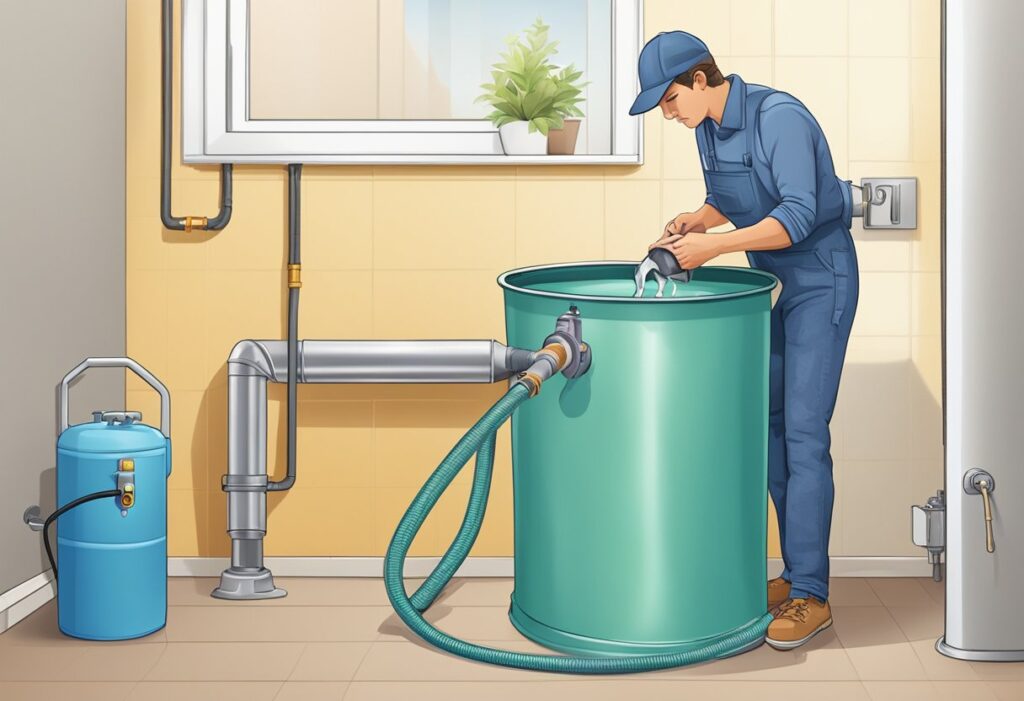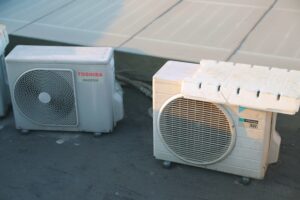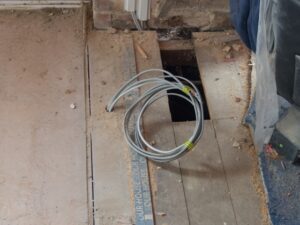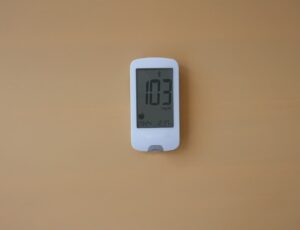Hot water heaters are essential for comfortable living, and keeping them in good condition is crucial. Have you ever noticed your water heater making strange noises or noticed a dip in hot water efficiency?
It could be the buildup of sediment inside. Sediment buildup is not only annoying, but it can also cause your heater to work harder, leading to higher energy bills and even shortening its lifespan. But don’t worry – draining and cleaning your water heater is easier than you think!
With a few basic tools and a little bit of effort, you can maintain your hot water heater and keep it running efficiently for years to come.
Not sure if you want to tackle this yourself?
Excel Mechanical is here to lend a hand! Whether it’s a small repair or a full system overhaul, we provide top-notch HVAC and plumbing services tailored to fit your needs and budget.
In this guide, you will learn:
- How to safely turn off your heater before starting the draining process.
- The correct way to flush out sediment buildup for improved efficiency.
- Tips for checking and maintaining your water heater for longer lifespan.
So, let’s get started with the basics of water heater maintenance!
Understanding Your Hot Water Heater
Hot water heaters come in various types, each with its features and benefits. It’s also essential to take safety precautions and prepare properly before draining and cleaning your heater.
Making informed decisions can help you maintain your system effectively.
Types of Hot Water Heaters
There are several types of hot water heaters to consider.
- Storage tank heaters are the most common. They store and continuously heat water in a tank.
- On the other hand, tankless water heaters heat water only when needed, which can save energy.
- Solar water heaters use energy from the sun for those interested in eco-friendly options.
- Heat pump water heaters move heat from the air to heat water, using less electricity than traditional methods.
Knowing the differences can help you choose the best one for your needs.
Safety Precautions and Preparation
Before working on your hot water heater, take safety precautions seriously.
- First, turn off the power supply. For electric heaters, switch off the circuit breaker.
- For gas heaters, set the thermostat to “pilot” mode.
- Let the water cool for several hours to prevent burns.
- Gather the necessary tools like a garden hose and a bucket.
- Securely attach the hose to the drain valve to direct water safely.
These steps help prevent accidents and make the process smoother.
Initial Steps Before Draining
Before you start draining your hot water heater, you need to prepare by turning off the power and water supply. This ensures safety and prevents water damage. Proper temperature settings also help protect the heater and your plumbing system.
Shutting off the Power Supply
- First, locate the circuit breaker for your water heater and switch it off.
- If you have a gas water heater, shut off the gas valve completely. This step ensures your safety and protects your equipment while you work.
- When handling the power supply, make sure to identify the correct breaker to avoid electric shock.
- If you’re not certain, use a voltage tester to ensure no electricity flows to your unit.
- For those with gas heaters, check for the smell of natural gas to ensure that no gas leaks are present.
If you detect any issues, contact a professional immediately.
Water Supply and Temperature Settings
- Locate the cold water valve at the top of the heater and turn it off. This prevents new water from entering the tank during the draining process.
- Next, adjust the temperature to a low or pilot setting to avoid damage or injury.
- Turning off the water supply allows you to work without the risk of flooding or scalding.
- Ensure that all hot water faucets in your home are also turned off. This helps the heater drain effectively without interruption.
Draining the Hot Water Heater
To drain a hot water heater, connect a hose to the drain valve, open the drain valve, and flush the tank. This ensures the removal of sediment and maintains the water heater’s efficiency.
Connecting a Hose to the Drain Valve
- Start by turning off the water heater’s power. If it’s electric, switch off the breaker.
- For gas heaters, set the control to the pilot setting. Let the water cool for safety.
- Attach a garden hose to the drain valve at the heater’s base. Make sure the hose fits securely to prevent leaks.
- Next, extend the hose to a drainage location, like a floor drain or outside, ensuring it’s lower than the drain valve to aid the water flow.
- Double-check that the hose is secure to avoid any water spillage or damage during draining. This step is crucial to ensure a clean and effective draining procedure.
Opening the Drain Valve
- Once the hose is connected, open a nearby hot water tap to relieve pressure in the system. This step helps facilitate the draining process.
- Carefully open the drain valve using a flathead screwdriver or a similar tool if necessary.
- Let the water flow through the hose completely. It’s vital to monitor the process to ensure there are no blockages.
- It’s also a good idea to periodically check the water color, as clear water indicates that most sediments have been flushed out.
- Once the drain is complete, ensure you close the drain valve tightly to avoid any leaks when you refill the tank.
Flushing the Tank
You should let additional water flow into the heater while the drain valve is open to flush the tank. This action helps remove stubborn sediment at the bottom of the tank.
Turn on the cold water supply, allowing fresh water to flow through. Monitor the output until the water runs clear, signaling a thoroughly flushed tank.
Once done, close the drain valve and remove the hose. Turn on the water heater’s power or relight the pilot light for gas models. This maintenance task ensures your system runs efficiently and prolongs its life, saving potential repair costs.
Excel Mechanical provides expert HVAC and plumbing services for any questions or assistance. It emphasizes quality and helps meet individual needs and budgets.
Cleaning the Hot Water Heater
Regular cleaning of your hot water heater ensures efficiency and longevity. The key steps involve removing sediment and inspecting components. Each process plays a vital role in keeping your heater running smoothly.
Removing Sediment
Sediment buildup can hinder the performance of your water heater.
- Begin by turning off the power or gas supply and letting the water cool.
- Attach a hose to the drain valve at the bottom of the tank and run it to a suitable drain location.
- Open the valve and let the water and sediment flow until it clears.
This process helps maintain the heater’s efficiency and can be essential for extending its life.
Inspection and Cleanup of Components
After draining, inspect various components, such as the anode rod and heating elements. Look for signs of wear, corrosion, or rust, which may need replacement.
If the anode rod is worn, replacing it can prevent rust and extend the heater’s life. Clean around the heating elements and ensure all connections are tight. Regular inspection helps prevent future issues and supports consistent water heating performance
Refilling and Restoring the Water Heater
You must follow a few important steps to get your water heater up and running again. This involves closing the drain valve, refilling the tank, and restoring power to ensure everything operates smoothly.
Closing the Drain Valve
After draining your water heater, ensure the drain valve is completely closed. Turn the valve clockwise until it sits tight. This step is crucial to prevent any leaks once you begin refilling the tank.
If you have attached a draining hose, disconnect it carefully. Check the valve area for signs of wear or leaks. If needed, consider replacing the valve or calling experts for their professional and reliable plumbing services.
Refilling the Tank
Start by gradually turning on the cold water supply to the heater. This prevents air from entering and reduces the risk of pressure buildup.
Keep an eye on the tank to see if it is filling smoothly. You can verify that it’s full by opening a nearby hot water tap to release any trapped air until the water flows steadily. Also, make sure there are no leaks around the heater.
Routine maintenance, including company inspections, ensures your system remains in optimal condition and is tailored to your needs and budget.
Restoring Power and Checking for Functionality
Once the tank is filled, you need to restore power. For electric heaters, switch on the circuit breaker. For gas heaters, relight the pilot or follow your model’s instructions to activate the burner.
Ensure your power source is stable and functioning well. Check the thermostat to confirm that it’s set to your preferred temperature.
Let the heater run and monitor the water temperature after some time.
If issues occur, such as inconsistent water temperatures or strange noises, it might be best to contact professionals to diagnose and address any potential problems.
Post-Cleaning Checks
After cleaning your hot water heater, it’s essential to ensure it’s working properly. Focus on checking for leaks and observing water quality and temperature to guarantee efficient performance and safety.
Checking for Leaks
Begin by visually inspecting your water heater and the surrounding area for any signs of leaks. Pay close attention to the connections and valves, as these are common places where leaks can occur. Use a flashlight for a clear view, especially in dim areas.
Run your fingers along the pipes and joints to detect moisture. If you find a leak, tighten the fittings or replace damaged parts. Plumber’s tape can sometimes help seal minor leaks around threaded connections.
Verify that the drain valve is completely closed. Conduct regular checks over the following days to ensure no new leaks develop. A sudden water drop in the tank could also indicate a leak.
Monitoring Water Quality and Temperature
Next, focus on testing the water quality.
After flushing, fill a clear glass with water from the heater to check for cleanliness. You want the water to be clear without any sediment.
Assess the temperature by testing the water at a nearby faucet. Adjust the thermostat if necessary to ensure it’s set to a safe level, typically between 120°F and 140°F. Monitor it for a few days to ensure consistent performance. Sudden temperature changes might mean the thermostat needs further adjustment or replacement.
If problems with water quality or temperature persist, reaching out to professionals can be crucial.
Maintaining Your Hot Water Heater
Keeping your hot water heater in good working condition involves regular care and knowing when to seek professional help. Simple maintenance steps can prevent problems, while expert assistance ensures safety and efficiency.
Regular Maintenance Tips
Routine checks can extend the lifespan of your water heater.
- Flushing the tank every six months helps remove sediment buildup, which can affect performance. Attach a garden hose to the drain valve and let the water flow out until it runs clear.
- Inspect the anode rod annually to prevent rust and corrosion. If it measures less than half an inch, replace it.
- Temperature settings should be adjusted to around 120°F to prevent scalding and reduce energy consumption. Additionally, check for leaks around the unit and inspect the pipes for any signs of wear. If the heater lacks insulation, consider adding a jacket to improve efficiency.
Always remember to turn off the power before performing any maintenance.
When to Call a Professional
Certain situations require professional help to maintain safety and efficiency.
Strange noises, such as popping or banging, indicate sediment accumulation. A professional can address this for you. Consistent water temperature fluctuations or unexpected cold showers might point to a failing heating element or thermostat.
If you notice leaks from the tank, contact a professional immediately, as this might indicate internal issues that warrant replacement.
Excel Mechanical specializes in HVAC and plumbing services, ensuring top-notch quality and great value. Our experts can assess your system for complex issues and provide solutions tailored to meet your needs and budget.
Relying on experts like us can enhance the longevity and performance of your heater.
Frequently Asked Questions
Dealing with hot water heaters can sometimes feel overwhelming, but don’t worry! We’ve gathered some common questions to make things a little easier for you. After all, a well-maintained water heater ensures you have a steady supply of hot water when you need it most.
So, if you’re wondering about how often to clean your unit, how to tackle stubborn sediment, or what signs indicate it’s time to call for professional help, this section will provide the insights you need.
What is the recommended process for flushing sediment from an electric water heater?
Flushing sediment involves turning off the electricity and water supply. Then, attach a hose to the drain valve and direct it to a suitable drainage area. Open the valve to let water and sediment flow out. Close the valve when the water runs clear, then refill the tank and turn the power back on.
Which steps are involved in cleaning a water heater with vinegar?
First, turn off the power and water supply. Then, drain some water from the tank. Add vinegar to the tank and let it sit to break down sediment. After a few hours, drain the vinegar and rinse the tank by refilling and flushing it again.
What are the signs that indicate sediment build-up in a hot water heater?
Signs of sediment build-up include noises like popping or rumbling from the tank, inconsistent water temperatures, and reduced hot water flow. These are clear indicators that it’s time to clean your heater to prevent damage and inefficiency.
Is it possible to clean a hot water heater using natural methods, and how?
Yes, you can use vinegar as a natural cleaning agent. It dissolves mineral deposits without harsh chemicals. Combining regular flushing with natural methods maintains efficiency and extends the lifespan of your heater.
How often should a hot water heater be drained and flushed?
You should drain and flush your water heater at least once a year. Regular maintenance helps remove sediment, improve efficiency, and extend the heater’s lifespan. In areas with hard water, more frequent cleaning may be necessary.
Can you explain how to properly use a flush kit to clean a hot water heater?
A flush kit typically includes a pump and hoses. Connect the kit to the water heater as directed. The pump circulates cleaning solution through the system, breaking down and removing sediment. Follow the kit’s instructions for the best results, and ensure the unit is completely rinsed before use.




